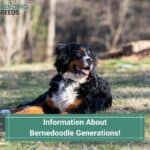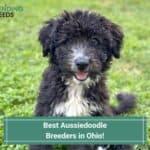
Aussiedoodle generations have become extremely popular in recent years. Crossing the intelligent Australian Shepherd with the devoted Poodle gives us the best of both breeds.
Aussiedoodles are loving, fun, and loyal dogs that make a fantastic addition to households of many kinds.
If you’re considering bringing one into your life, you have much to consider. People attracted to this breed are often looking for specific personality traits or want a hypoallergenic dog.
If this is you, it’s critical to understand the difference between the various generations, such as the F1BB Aussiedoodle, before bringing a dog home.
Keep reading to learn more about Aussiedoodle generations.
Other articles you would like: Popular Aussiedoodle Haircuts With Pictures! and Types Of Aussiedoodle Colors
Table of Contents
Why You Should Care About Aussiedoodle Generations

If you’ve never heard terms like F1, F2, or multi-gen before, you might think they’re unimportant. But you should care about and understand Aussiedoodle generations before committing to a dog.
There are seven, and knowing the basics is critical to picking a dog that fits well with your family and lifestyle.
Breeders cross Australian Shepherds and Poodles in various ways and over various generations to (hopefully) produce specific traits.
As such, you can expect differences in personality, appearance, and even potential health issues depending on the percentage of Poodle to Australian Shepherd.
For example, the temperament of the two parent breeds is quite distinct. You can expect different personalities if you have a dog with more Australian Shepherd than Poodle.
And if a curly coat that doesn’t shed is important to you, you’ll want a dog with more Poodle genes than Australian Shepherd genes.
Understanding Aussiedoodle Generations

Breeders explain genetic makeup through a combination of letters and numbers. These letters and numbers provide valuable insight into a dog’s:
- Temperament
- Appearance
- Health
At first glance, understanding the difference between F1, F1B, and F2 Aussiedoodle generations can seem complicated. In reality, it’s pretty simple. Here’s a quick overview to get you up to speed.
“F” Explained
All Aussiedoodle generations begin with an “F,” which means “filial hybrid.” For example, you may see an “F1B Aussiedoodle” generation. The term refers to a dog that came from two purebred parents. In other words, it describes a non-purebred hybrid dog.
“B” Explained
Sometimes you will see the letter “B” in the generation name, which means “backcross.”
“Backcross” is a complicated term, but it indicates that an F1 dog has been bred again with a purebred dog. When it comes to Aussiedoodles, we’re talking about either a 100% Poodle or 100% Australian Shepherd.
When breeders backcross their dogs, they nearly always do so with a purebred Poodle. More people want Poodle traits because these dogs are hypoallergenic and don’t shed fur.
What Does the Number Mean?
Finally, the number you see refers to the generation of the dog. An F1 Doodle is the first generation, an F2 Doodle is the second generation, and so on.
Sometimes, you may see “multi-gen” instead of a number, which means multiple generations. We’ll discuss multi-gen in further detail below.
What Is Hybrid Vigor?
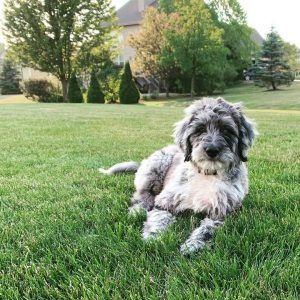
You’ll often hear the term hybrid vigor in breeding, and it’s one to keep in mind.
Mixed breeds have a healthy size gene pool, putting them at lower risk for certain genetic conditions.
On the other hand, purebred dogs have a relatively small gene pool and are prone to certain genetic concerns. Breeding two purebred dogs introduces a wider gene pool.
As a result, the offspring of these parent breeds are usually healthier – also known as hybrid vigor. Hybrid vigor is a positive thing, and it varies among Aussiedoodle generations.
Genetic Makeup of Aussiedoodle Generations

Visualizing the generations with percentages of their genetic makeup can be helpful. Here’s a brief overview of what percentage of Australian Shepherd and what percentage of Poodle you can find in each of the seven:
- F1 Aussiedoodle: 50% Australian Shepherd/50% Poodle
- F1B Aussiedoodle: 25% Australian Shepherd/75% Poodle
- F1BB Aussiedoodle: 12.5% Australian Shepherd/87.5% Poodle
- F2 Aussiedoodle: 50% Australian Shepherd/50% Poodle
- F2B Aussiedoodle: 37.5% Australian Shepherd/62.5% Poodle
- F2BB Aussiedoodle: 18.75% Australian Shepherd/81.25% Poodle
- F3 Aussiedoodle: Multi-generation
What Is an F1 Aussiedoodle?

An F1 Aussiedoodle is a basic cross between a Poodle and an Australian Shepherd. It’s the first generation, which means you get a 50/50 split of the parent breed’s DNA.
Genetic diversity is broad with first-generation dogs, and characteristics are difficult to predict. It’s impossible to say what kind of coat an F1 Doodle will have.
It could be curly like the Poodle or straight like the Australian Shepherd. Many F1 Doodles end up somewhere in between.
Shedding is equally difficult to predict. While an F1 Aussiedoodle will probably shed less than an Australian Shepherd, it will still shed.
The coat length and shedding are factors to consider for those with allergies. You’ll probably be better off with a different generation.
However, if you don’t have allergies or care about shedding this generation’s genetic diversity could be positive. Of all the generations, the F1 Aussiedoodle has the most hybrid vigor, so it’s likely to be the healthiest.
What Is an F1B Aussiedoodle?
The F1B Aussiedoodle is a cross between an F1 Aussiedoodle (50% Australian Shepherd/50% Poodle) and a purebred line – either a Poodle or an Australian Shepherd.
As mentioned above, most breeders choose to backcross the F1 Aussiedoodle with a Poodle instead of an Australian Shepherd to select for a non-shedding coat and hypoallergenic characteristics.
The opposite rarely occurs, so you can be sure that the backcross is with the Poodle.
Now, do you remember that “B” we talked about? Because this generation is backcrossed, it gets the F1B designation.
The F1B Aussiedoodle is one of the most popular generations despite having less genetic diversity. Indeed, having less genetic diversity is what makes it attractive for people with allergies.
You can reliably expect the wavy or curly coat characteristic of the dog’s Poodle parent. This coat is excellent for people with allergies but requires plenty of upkeep.
You can also expect more of the Poodle temperament from F1B Doodles. They’re typically high-energy and require lots of mental stimulation to keep them happy.
Finally, this generation still has plenty of hybrid vigor, though less than its F1 counterpart.
What Is an F1BB Aussiedoodle?
We get the F1BB Aussiedoodle by mixing an F1B Aussiedoodle and a purebred dog, either an Australian Shepherd or a Poodle.
Again, the Poodle is almost chosen as the purebred parent, which nearly guarantees the offspring will not shed and will be hypoallergenic.
You’ll notice the second “B” in the generation name, which indicates that this dog is the second backcross. However, breeders may simply refer to it as a “multi-gen” dog since F1BB Aussiedoodles are technically the third generation of the breed.
Because they’re the third generation, they have less hybrid vigor than F1 or F1B Aussiedoodles.
But if you’re looking for the most hypoallergenic of the generations, the F1BB is your best bet. You’ve got the most Poodle genes in an F1BB, so the dog’s coat is almost always extremely curly.
Remember, regular grooming and maintenance are essential with this generation, lest your dog develop unruly tangles or matting.
Despite the downsides of grooming, F1BB Aussiedoodles are the best for people with allergies or people who don’t want dog hair all over their homes.
For this reason, they’re highly popular, which may make finding an F1BB Aussiedoodle for sale challenging.
What Is an F2 Aussiedoodle?

Once we start talking about F2 generations, things get a bit confusing. Mainly because an F2 Aussiedoodle may be one of several different combinations. In general, we can say that it’s the second filial generation of an Aussiedoodle.
In other words, an F2 Aussiedoodle is the cross of an F1 Aussiedoodle and another F1 Aussiedoodle.
The offspring’s genetic makeup is the same as its F1 parents: half Poodle and half Australian Shepherd. Because the percentages are the same, an F2 Aussiedoodle is pretty similar to F1 Doodles.
Breeders often stay away from creating F2 Aussiedoodle mixes because of the unpredictability of the genes. They can never be 100% sure what kind of coat, personality, or hypoallergenic features the dog will have.
And because it’s difficult to predict whether the dog will shed, pet owners tend to steer away from them, too.
What Is an F2B Aussiedoodle?
Next in the second generation of Aussiedoodles is the F2B. Because of the “B,” we know these dogs have been backcrossed. The combination is usually an F1 Aussiedoodle and an F1B Aussiedoodle.
However, some breeders go a different route and choose to breed two F1B Aussiedoodles. This mix brings more Poodle characteristics into the dog, notably the wavy or curly coat.
F2B Aussiedoodles are nearly always non-shedding and hypoallergenic. They have a decent amount of hybrid vigor.
Although the technical name is F2B, many breeders refer to this generation as multi-gen. This classification is because F2B dogs are technically third-generation dogs.
What Is an F2BB Aussiedoodle?
The F2BB Aussiedoodle is a mix of a purebred Poodle and an F2B Aussiedoodle. You’ll notice the two “B”s in the title, which means the dog has been backcrossed two times.
If you’re looking for the most hypoallergenic, non-shedding dog from the second generation, the F2BB is it. It’s got mostly Poodle genetics, so you’re all but guaranteed these characteristics.
And if we compare it to other generations, the F2BB ranks only slightly behind the F1BB Aussiedoodle for Poodle genetics.
As with the F2B Aussiedoodle, most breeders refer to the F2BB as a multi-gen. It’s technically the fourth generation, which also means it has good hybrid vigor – though the F2 and F2B Aussiedoodles generations have more.
What Is an F3 Aussiedoodle?

Finally, we have the F3 Aussiedoodle. F3 Aussiedoodles are the third generation or higher. As we’ve seen, they’re commonly referred to as multi-gen Aussiedoodles.
You can find different combinations of F3 Doodles. In many cases, breeders will cross two F1B Aussiedoodles. However, some F3s have two F2 Aussiedoodles as parents.
Whatever the mix, the third generation has a majority of Poodle genetics. People with pet allergies tend to like these dogs. Their coats are between wavy and very curly, so they shed less and are hypoallergenic.
It’s critical to remember that the multi-generation tag can apply to any Aussiedoodle after the second generation. As mentioned above, even second-generation dogs might be multi-gen, including the F1BB, F2B, and F2BB.
Lots of breeders use this label instead of the generation. If you see it, it’s best to ask for further clarification about the dog’s generation.
What Aussiedoodle Generation Should I Get?
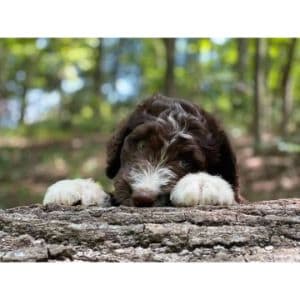
Now you know that the personality, appearance, and features of an Aussiedoodle can vary significantly based on its generation. You might be wondering which is the best one for you.
Ultimately, the best Aussiedoodle generation will depend on your circumstances. If you have allergies, some choices are safer than others. The best bet would be the following generations (in this order):
- F1BB Aussiedoodle
- F2BB Aussiedoodle
- F1B Aussiedoodle
- F2B Aussiedoodle
Remember that some people may still have allergic reactions to hypoallergenic dogs. Spending time with the breed is always best to see how your allergies respond before committing.
But you have more options if allergies or fur aren’t significant factors. The F1 Aussiedoodle, in particular, is an excellent mix of two fantastic breeds. They have the most hybrid vigor, so you’re less likely to run into health problems in the long run.
Because their traits are less predictable, they tend to be less expensive than other generations.
Of course, the health of any dog depends significantly on the breeder. Finding a reputable one is not always easy, but it’s time well-invested.
Aussiedoodle Generations
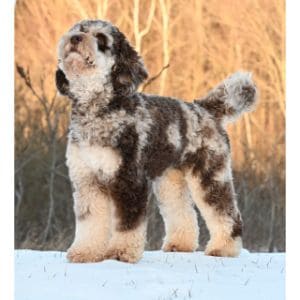
If you’re considering adopting an Aussiedoodle, you may be confused about the different generations. The above information can help you understand the features of the various Aussiedoodle generations to help you find the perfect fit for your family.
Remember to purchase from a reputable breeder to ensure a long and healthy life for your new furry friend.
You will also like:
- How Much Exercise Does An Aussiedoodle Need?
- When Is An Aussiedoodle Full Grown?
- Do Aussiedoodles Need Grooming?
For more information about the Aussiedoodle Breed, check out the video below:

